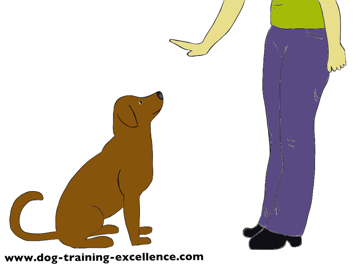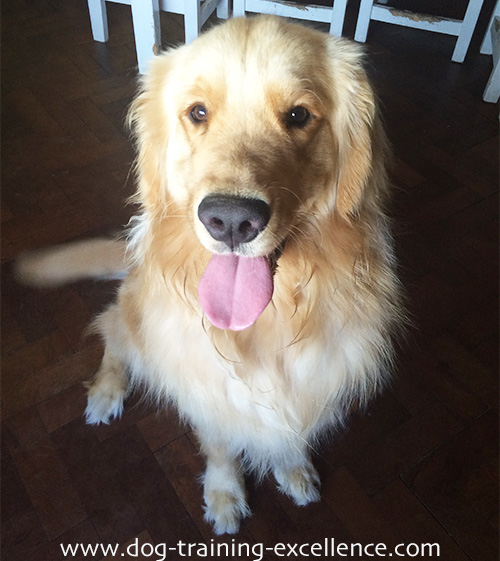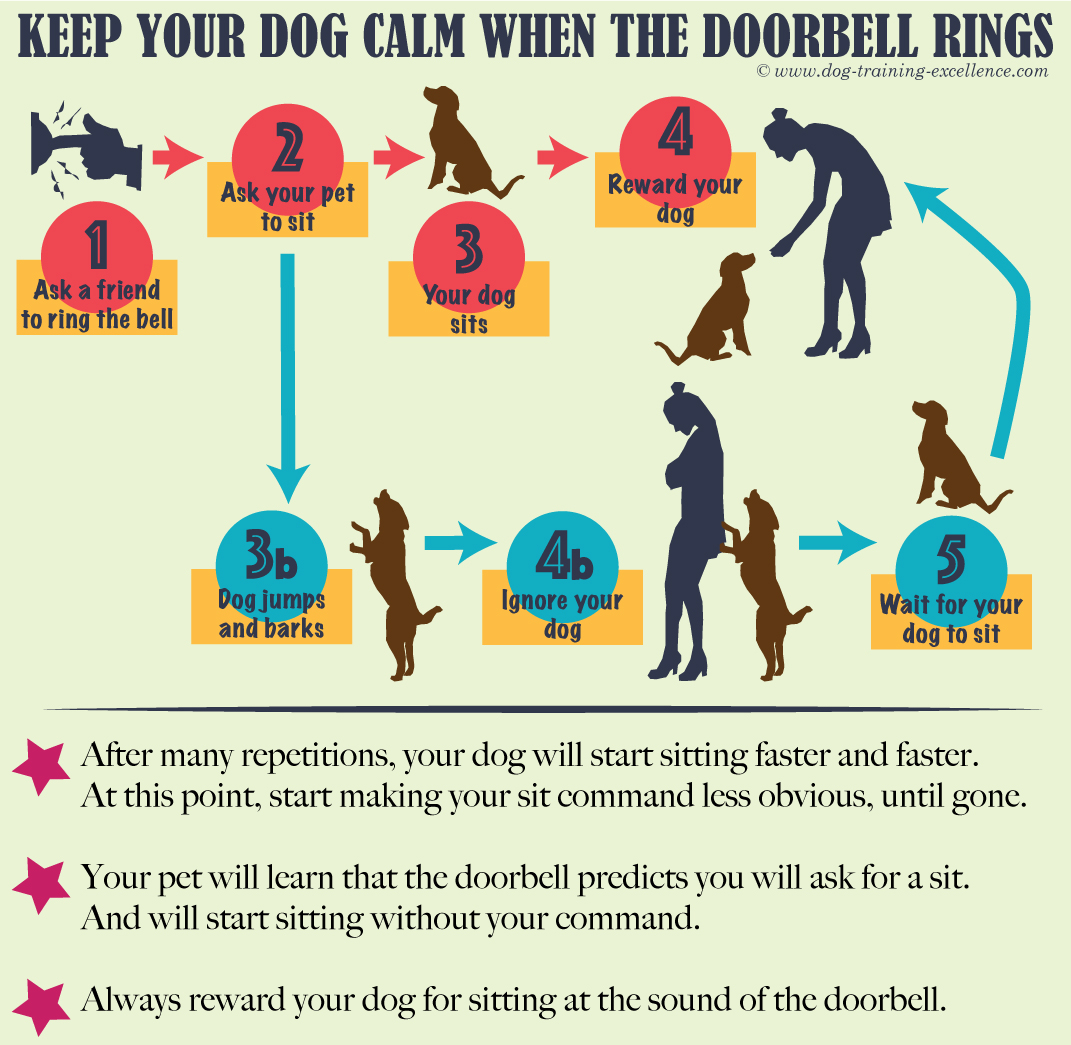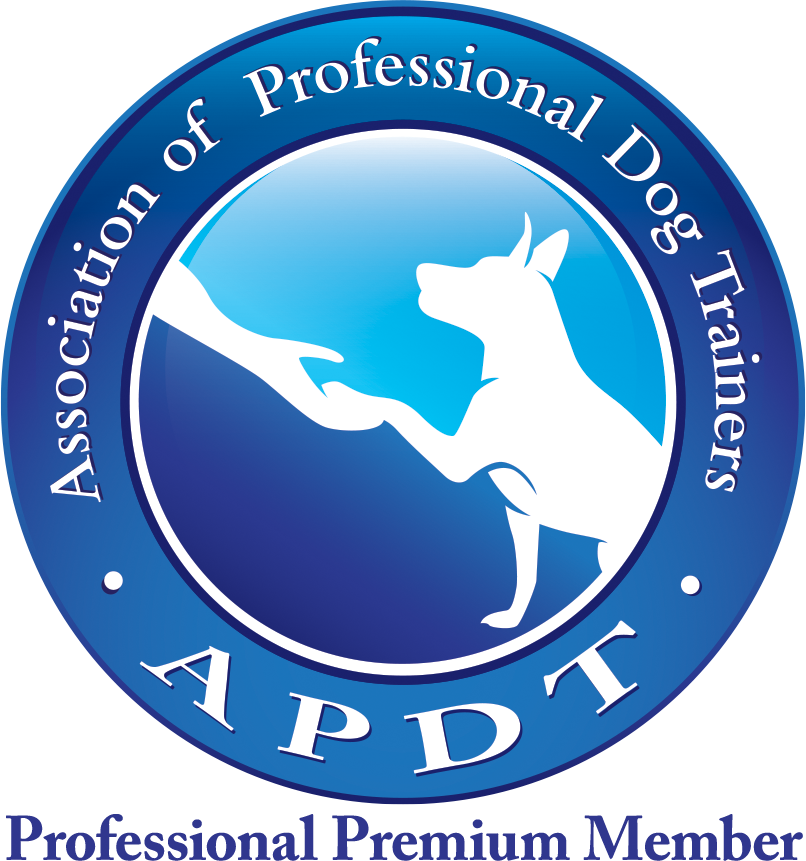I try to write my posts as unbiased as possible and recommend the products I consider to be useful and the best. I use affiliate links, this means that–at no extra cost to you–I can make a commission on a purchase you make after clicking on them. As an Amazon Associate I earn from qualifying purchases.
Barking dog solution:
Keep your dog calm when the doorbell rings
Do you need a barking dog solution? Are you wondering how to keep your dog calm when the doorbell rings? Do you want your pet to stop jumping on people entering your home? This is a step-by-step tutorial that will help you stop nuisance barking every time someone is at the door. Practice, patience and some treats is all you need!
The goal is to teach your hound that when the bell rings he has to do something that is incompatible with barking.
For example, when the doorbell rings, he has to run and find a dog toy and bring it to you. Another option is for your hound to sit and stay in a specific spot.
You can choose any behavior you want and the training method will be very similar. Below is an example to train your canine friend to sit and stay when he hears the bell ring.
If your hound barks for other reasons (boredom, fear, guarding, etc.) check out the Barking Dog Solutions Main page for more help.
Barking dog solution to stop barking at the doorbell
Barking dog solution STEP 1: Sit and Stay anywhere!
Before you can teach your dog to be calm when the doorbell rings, you must teach him to Sit and Stay on cue. It is very important that your pet can do these reliably when there is no-one at the door. Slowly, you will add distractions but before your pet can successfully sit calmly at the door for guests, he must be able to sit calmly at the door when there is no one outside.
Never push your dog to do more than what he can, this will only frustrate him. Dog training must be fun and enjoyable. Your dog barks at the doorbell because he is excited. He jumps at people because he is happy to see them and wants to say "Hi!". To teach him to be calm during these events, he has to learn that being calm is better than being out of control. For example, if you sit quietly, you will get a reward AND get to say "Hi!" to the guests too!
Practice sit-stays with your dog everywhere you can, in every room of your house, near the door, when out for walks, when guests are already inside your house. The more places you practice, the easier the next steps will be to find a barking dog solution to keep your dog calm when the doorbell rings.
Barking dog solution STEP 2: Pavlov's Bell
For this step you will need the help of a friend or family member. This person will stay outside and ring the bell at random intervals. For example, ring the bell after 1 min, 3 min 5 min, 30 sec, 8 min, etc. You may also record the sound of your doorbell in your cell phone and practice on your own. This is specially helpful if your dog gets completely out of control, because you can start with a lower volume. However, I find that dogs quickly realize the sound from your cell phone is NOT the same as the doorbell ring, and stop barking much quicker but will still bark at the real sound.
While your helper is outside, you will be inside your house with a lot of the yummiest treats you can find. If your dog goes berserk at the sound of the doorbell, then you need high-value treats. These are treats that will get his attention no matter what!
TIP
 |
Use healthy and irresistible treats to motivate your dog, then be consistent: Ignore your pooch if he doesn't respond to your cue promptly or you need to ask a second time. For a food reward your hound needs to react the first time you ask! GIMBORN 731058 Pro Treats for Dogs Freeze Dried Pork Liver Treats for Dogs, 12-Ounce |
Immediately after you hear the bell ring, give your dog a treat. It doesn't matter if he is barking, put the yummy piece of chicken in front of his nose and as soon as he smells it let him have it.
During this step, you will be using classical (or Pavlovian) conditioning. Classical conditioning is the most basic way of learning, we associate a stimulus (e.i. the doorbell) with a consequence (e.i. food). Before this exercise, your dog probably had a mixed emotion when he heard the doorbell ringing. He was excited, maybe scared, trying to alert of a possible intruder, who knows really! The point is that his emotions where not always positive. After you do this exercises, you will change that negative association for a positive one. Now, when your dog hears the doorbell he will be happy because he knows a reward is coming.
You can practice this in short sessions, maybe 10-15 rings per session; 1-2 sessions per day. You will know when your dog is ready to go to the next step because when the doorbell rings, he will look at you expecting food instead of barking.
Note: He is not required to sit during this step, if he does it - Great!- but if he doesn't it's OK too. He just needs to be quiet for half a second while he chews on his food. This is all we are looking for in this step.
Won't I be rewarding my dog for barking?
That is a great question! Initially, you just want your dog to associate the sound of your doorbell with food, that is why you will reward him EVEN IF he is barking. However, as soon as he starts getting it, you will notice that he will hear the bell and HESITATE before barking. You must be quick and reward while he is quiet, you may have half a second to react!
So, the first several rewards may be while your dog is barking, but as soon as possible, you want to switch and try to give him the treat just BEFORE he starts barking.
Barking dog solution STEP 3: Riiiiing means SIT!
Now that your dog has a positive association with the sound of the doorbell, it's time to ask for a little bit more. There is still more work to stop your dog from barking at the doorbell.
Again, ask a helper to ring the bell at random intervals so you can practice with your dog inside the house.
Within two seconds of hearing the doorbell ask your dog to sit. If he does, give him a treat right away. If he doesn't you can try luring your dog into a sit with a treat in your hand (the same way you taught him how to sit) and as soon as he sits, give him the treat.
If your dog is to hyper to sit, then you need to go back to the previous step and practice a little bit more. Keep practicing until your dog hears the doorbell and looks at you for the treat, then hold the treat for 1 to 2 seconds and if he is still calm, give him the treat. The idea is to teach him to expect a treat calmly for a second after the doorbell rings. Then, come back to this step again.
In the previous step, we were teaching your dog that the doorbell ring meant food. During this step we are teaching him that the doorbell means he must sit to receive he food.
There is a chain of events, this is a very important chain of events, and you must practice it until the dog does this automatically:
DOORBELL ☞ SIT! Command ☞ Dog Sits ☞ Reward.
Star with 10-15 repetitions and 2-3 sessions per day. At this point, you can also do this if someone rings the doorbell for real!
As you see that your dog starts understanding the chain of events, start making the "Sit!" commands less and less obvious. In fact, you can sometimes wait for your dog to sit after the doorbell rings and then reward him (without asking him to sit). Your goal is for the chain of events to change to:
DOORBELL ☞ Dog Sits ☞ Reward.
Now your dog has learned that the doorbell is the same as the cue for sit!, and if he does sit he will receive a reward! This barking dog solution teaches your dog to make the right decisions.
Barking dog solution STEP 4: How long should you use rewards?
I recommend rewarding your dog for sitting at the sound of the doorbell for a long time, until you are sure your dog is reliable, understands and enjoys this exercise. When your dog has learned to sit reliably, then you can start giving rewards randomly. Sometimes you can forget the reward, but still give him verbal praise.
During this step, you can also choose to give him a treat if he did a particularly difficult sit, or reward the best responses. So, instead of random rewards you are picking and choosing to perfect his response. Examples of best responses are: he sat faster, he sat and was calm (not shaking or whining), he sat and looked at you.
Barking dog solution STEP 5: Adding the stay

Now that your dog sits when the doorbell rings, it's time to work on a solid stay.
If you haven't already, read the article about "stay" because it is important to work slowly so your dog can succeed. During this step you will work two different situations (one at a time) and then put them together.
Situation 1: You move away from the dog and towards the door (but do not open it). You must choose where (at which distance from the door) you would like your dog to sit when the doorbell rings and practice from that spot every time. Ask your helper to ring the doorbell at random intervals (longer this time) and after the doorbell rings, wait for your dog to sit (or ask him to sit in the correct spot), then move one step away from your dog (and towards the door). Immediately after this, go back to your dog, give him a treat an release him with a cue.
Slowly keep adding distance until you reach the door. Your goal is for your dog to sit after the bell rings, and stay while you walk towards the door and back to him for a reward. For this barking dog solution to work, you may have to do several training sessions.
Situation 2: In a different set of training sessions you will teach your dog to stay while you open the door. Start with your dog close to the door (we do not want to train distance and door opens at the same time!), after the bell rings, wait for your dog to sit, then touch the handle and give him a treat.
With many repetitions you will progressively open the door and step outside for 5 seconds. The training sessions may go something like this (every step must be repeated several times before moving to the next):
- Take your keys out of your pocket and move them
- Take your keys out of your pocket and place them in the keyhole
- Touch the handle
- Move the handle up and down
- Place the keys on the keyhole and touch the handle
- Place the keys on the keyhole and move the handle up and down
- Move the handle up and down and open the door an inch, close it
- Open the door two inches, close it
- Open the door progressively more and more until it is wide open
- Put the keys on the keyhole, touch the handle and open the door (you may need to open it a little bit and progressively work your way to opening it completely again
- Open the door and step outside for 1 second
- Open the door and step outside for more seconds progressively
- Put the keys on the keyhole, touch the handle and open the door and step outside
You may want to advance quickly because your dog is too smart, I strongly suggest you move slowly and build practice and confidence on each step. You dog will learn to be calm faster when the doorbell rings if you move slow.
Situation 3: It is time to add distance and open the door. After the doorbell rings, ask your dog to sit at a distance from the door, then walk to the door and repeat all the steps from the previous situation. Your dog may learn a bit faster this time because he already did the previous exercise.
At the end of this barking dog solution step, your dog should be able to sit at a distance from the door after the doorbell rings and stay while you walk towards the door, open the door and step outside for 5 seconds.
Barking dog solution STEP 6: Adding people

The last step in this exercise is to add people coming in through the door. Again, I recommend you go slow to train your dog to be calm when the doorbell rings.
Situation 1: Ask a friend to help you and start without the doorbell ringing. This is because we first want to teach your pooch to sit when someone comes in (instead of jump up) and the doorbell sound will be too distracting.
Ask your friend to wait outside the door, go and open the door. Let your dog do its thing, he may go and jump up to greet your friend. If this is the case, ask your friend to turn around, cross is arms in his chest and ignore the dog. IGNORE = NO looking at the dog, NO talking to the dog, NO pushing the dog, NO touching the dog. At some point, your dog will put his four paws on the ground tired of trying to reach your friend. AT THAT POINT your friend must turn around and pet your dog. If the dog jumps up again, repeat the ignore (if jumping)/ pet if 4 paws are on the floor.
Repeat this step with the same person (coming and going) until our dog greets your friend without jumping. Now, ask your friend to ask your dog to sit before petting him. Repeat until your dog sit perfectly to wait to be greeted.
Your dog may advance quite rapidly because you will be using the SAME person over and over again. So, the next step is to ask several friends to help you and repeat this same step with every single one of them.
Situation 2: Putting it all together to keep your dog calm when the doorbell rings. Now, ask your friends to do the same as before, but the exercise will start with the doorbell ringing. So, doorbell rings, your dog sits at a distance and stays while you open the door, then give the release signal for your dog to come greet the person, the person asks for a sit pets the dog and can even give him a treat!
You did it! Depending on the level of excitement your dog has this whole process make take several days, several weeks or even several months. Each dog works at their own speed, be patient, be consistent, be clear and you will train your dog to be calm when the doorbell ring successfully!
What to do about failed responses?
Tip
Never punish a happy and excited dog. If you do this you might be teaching him to be afraid of guests and that is a much difficult problem to solve!
If your hound breaks the sit-stay when the person enters through the door, call him to the spot to sit again (while the person retreats and goes back outside closing the door) and do not give him a food reward. Treats only come when he responds correctly.
Harsh verbal or physical punishments are not necessary and can even be detrimental to teach your dog to be calm when the doorbell rings. For this barking dog solution to work, you want your pet to relax and enjoy the exercise. If he is stressed or afraid of being punished, he may resort to other bad behaviors.
Barking dog solution EXTRA STEP 7:
Entertain your pet while you visit with your guests
It may be your case that when you have guests at home your dog won't stop begging for attention or wanting to play and interact with your guests, even in an annoying manner.
This step is to teach your dog to be calm while you enjoy visiting with friends and family.
First, I highly recommend that you give your dog a nice long walk in the park before the guests arrive.
Second, if you have guests that like dogs, after they come in ask them to play with your dog for 5 minutes. If they don't, then you can play with your dog for 5 minutes. Good games to play are tug-of-war and fetch.
Third, after playing for 5 minutes tell your dog - Enough - (in a calm manner) and give him an interactive toy to enjoy on his own. Below are some of my favorite interactive toys for these type of occasions. You want a toy you can fill with something spreadable, like peanut butter or cheese because you want your dog to be calmly licking or chewing on something. I do not recommend interactive toys that make your dog kick it or run with it in his mouth. We want to encourage calm behavior.
Hope this tutorial for a barking dog solution to keep your dog calm when the doorbell rings helps you. You can tell us your story in the box below!
Home > Stop Dog Barking > Barking at Doorbell





New! Comments
Questions? Anecdotes? Tips? Leave me a comment in the box below.